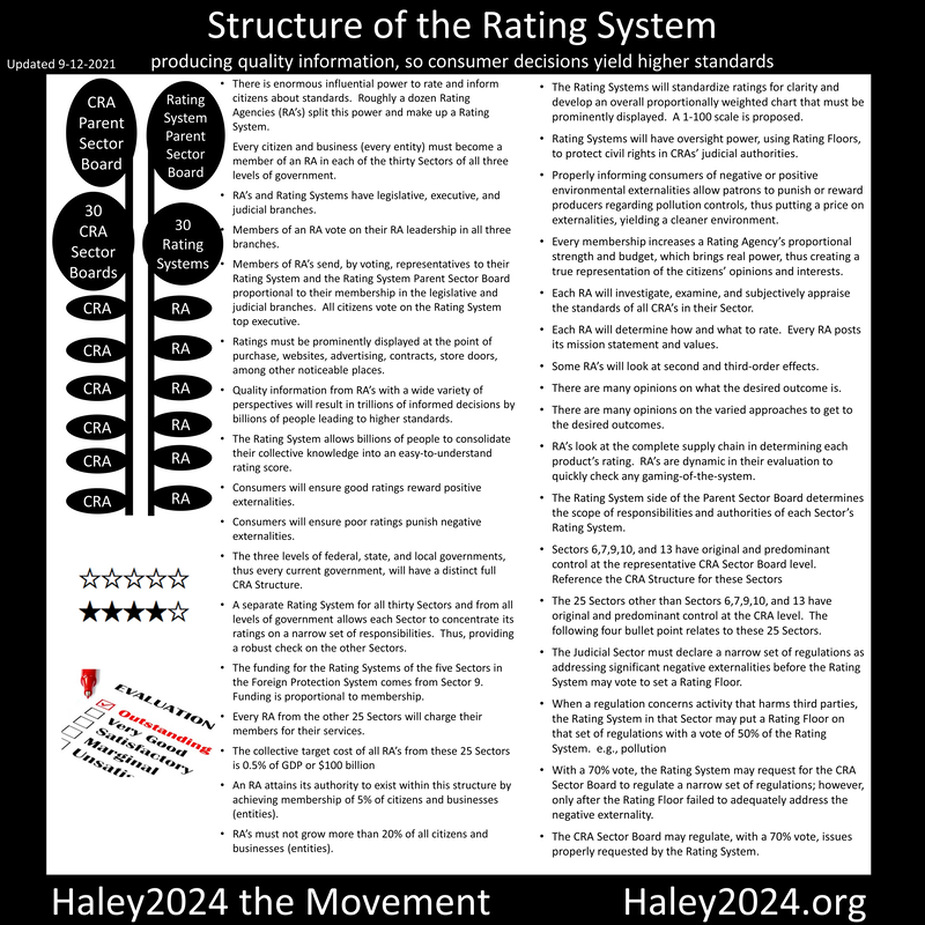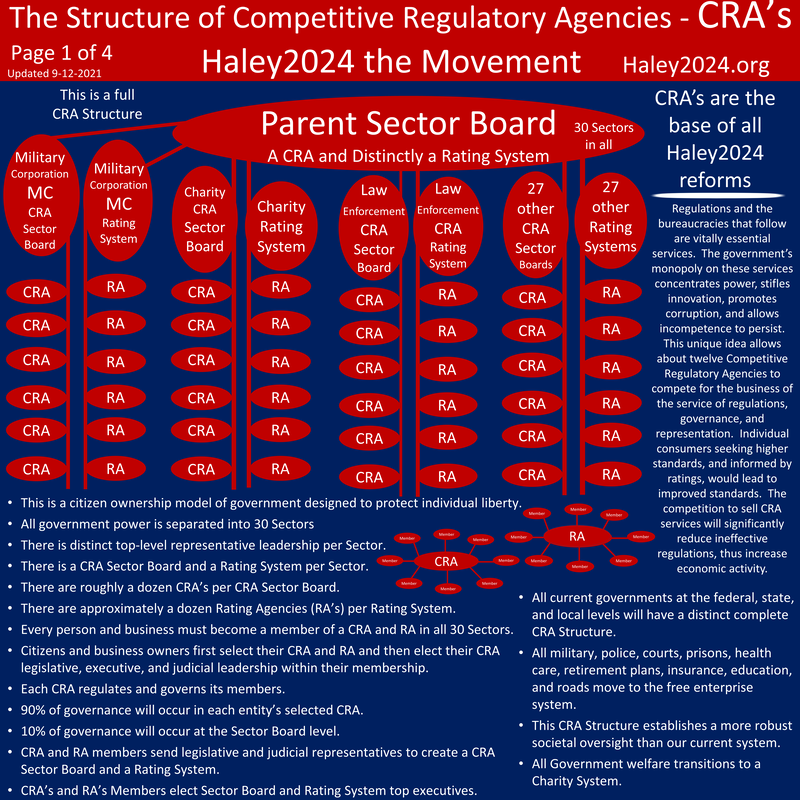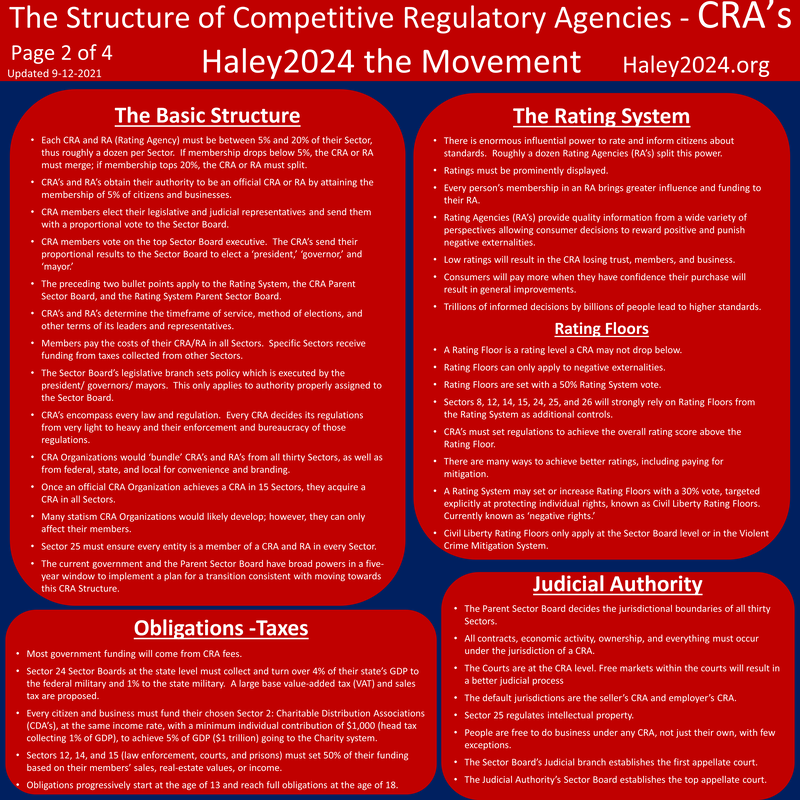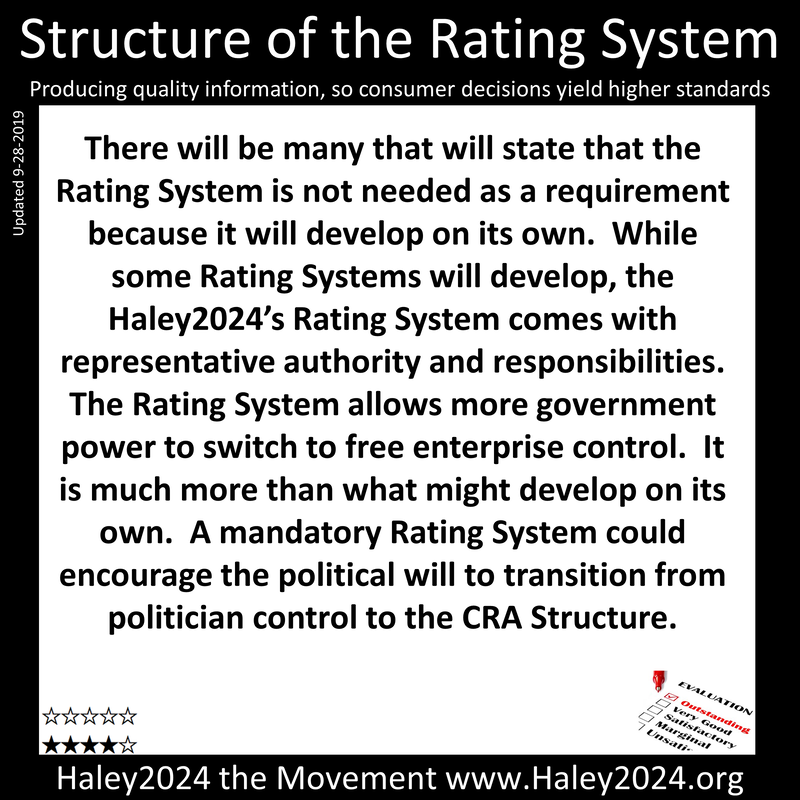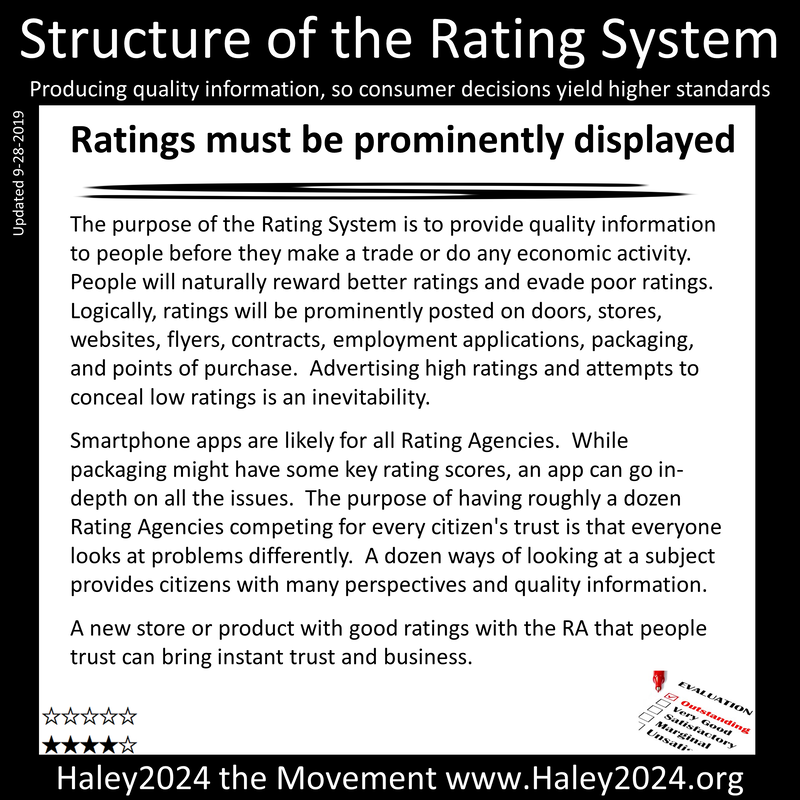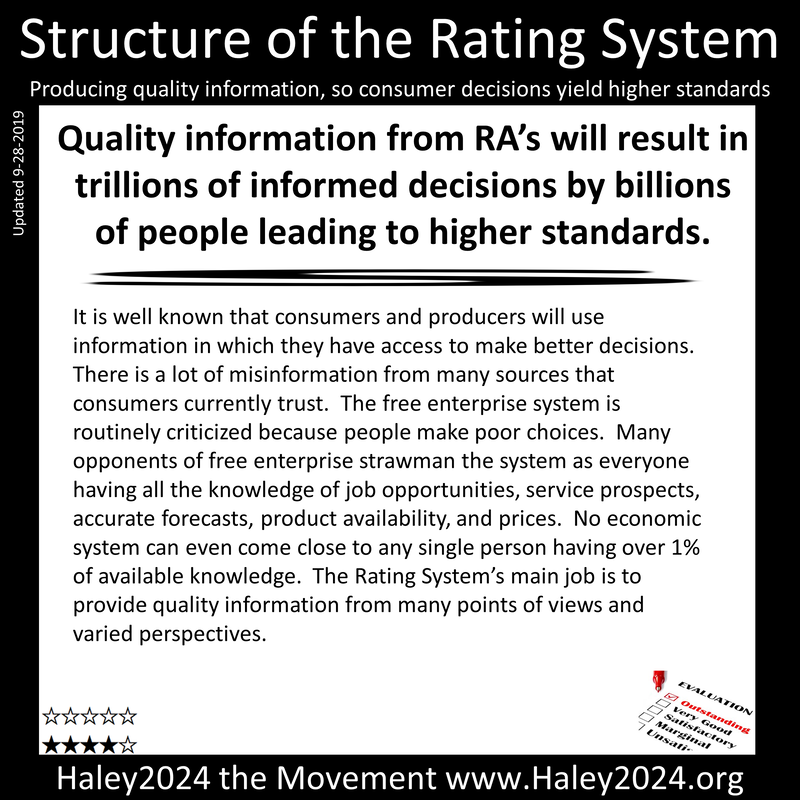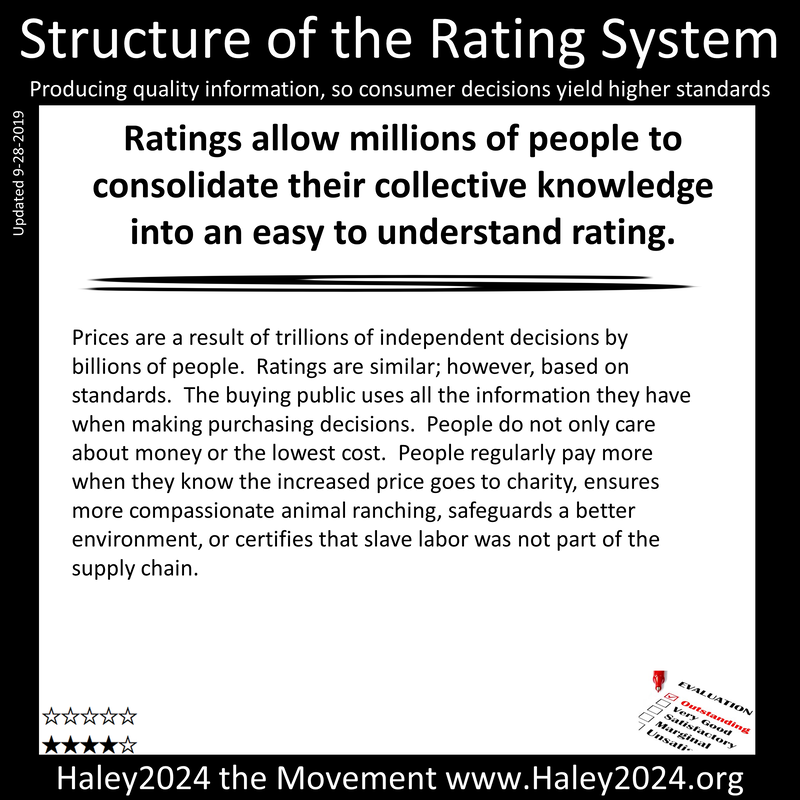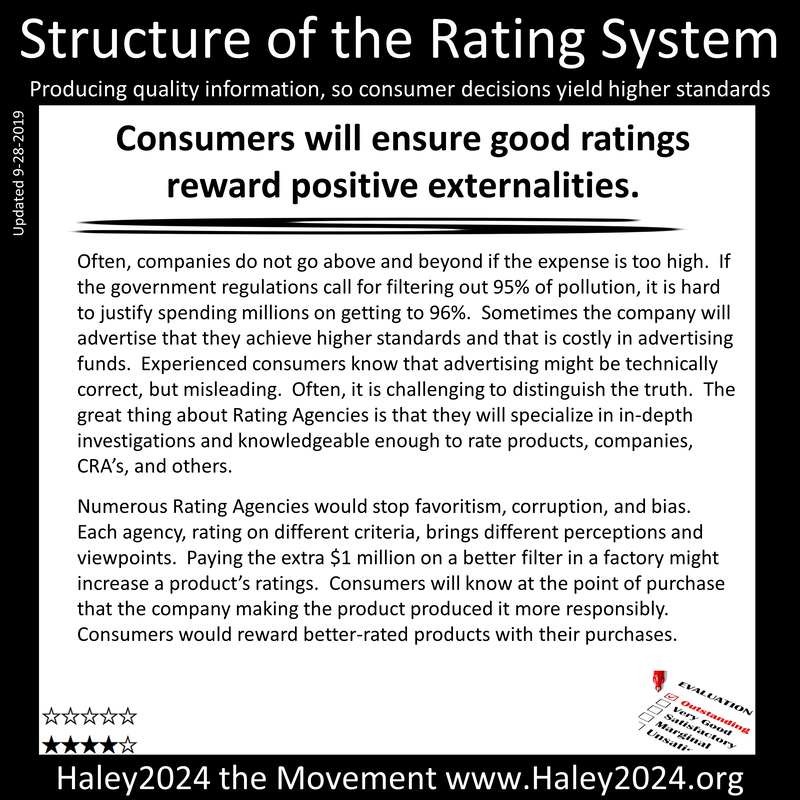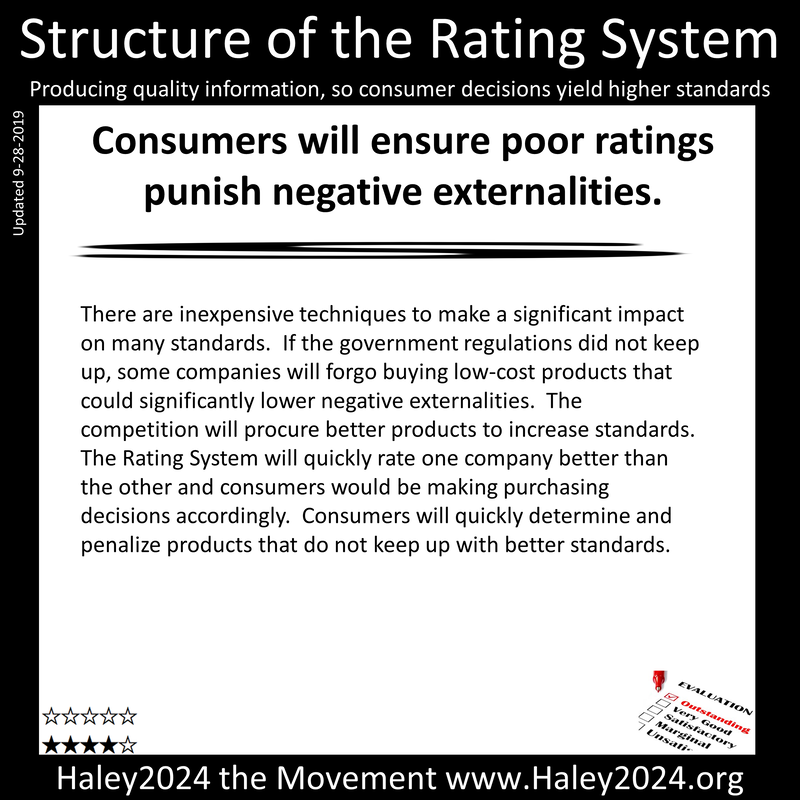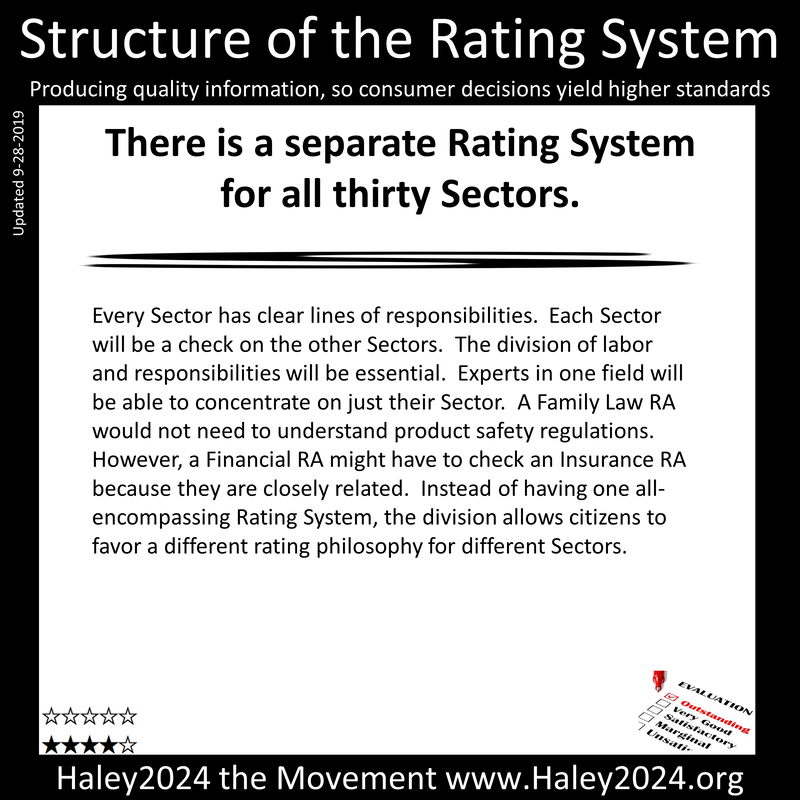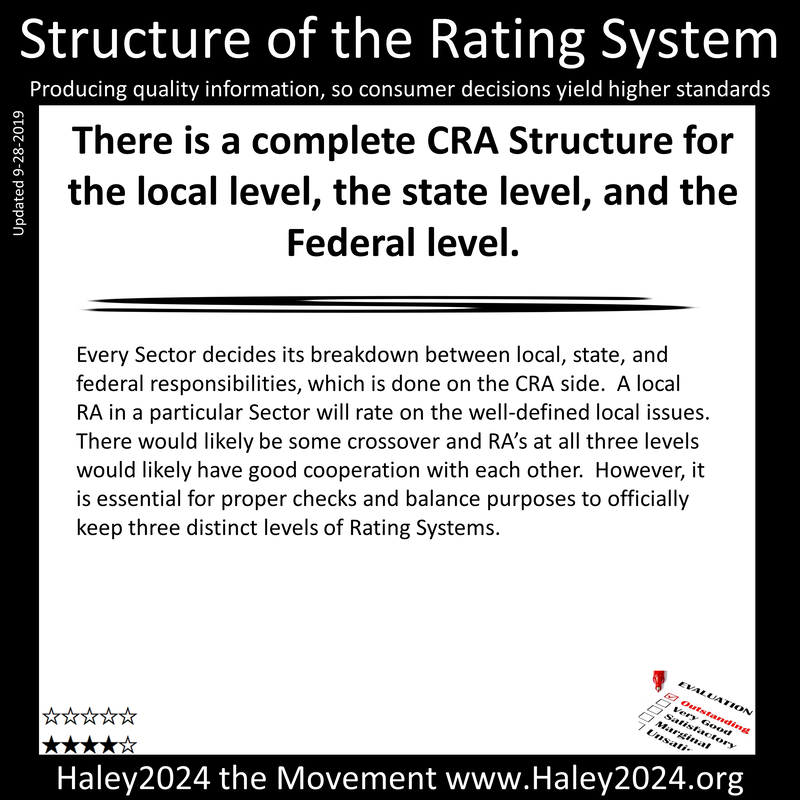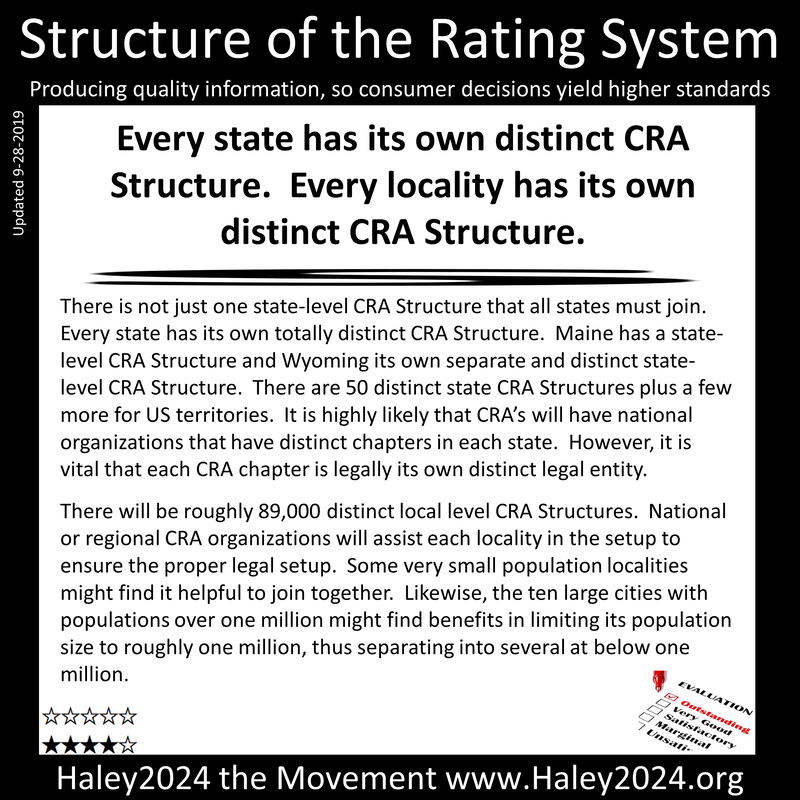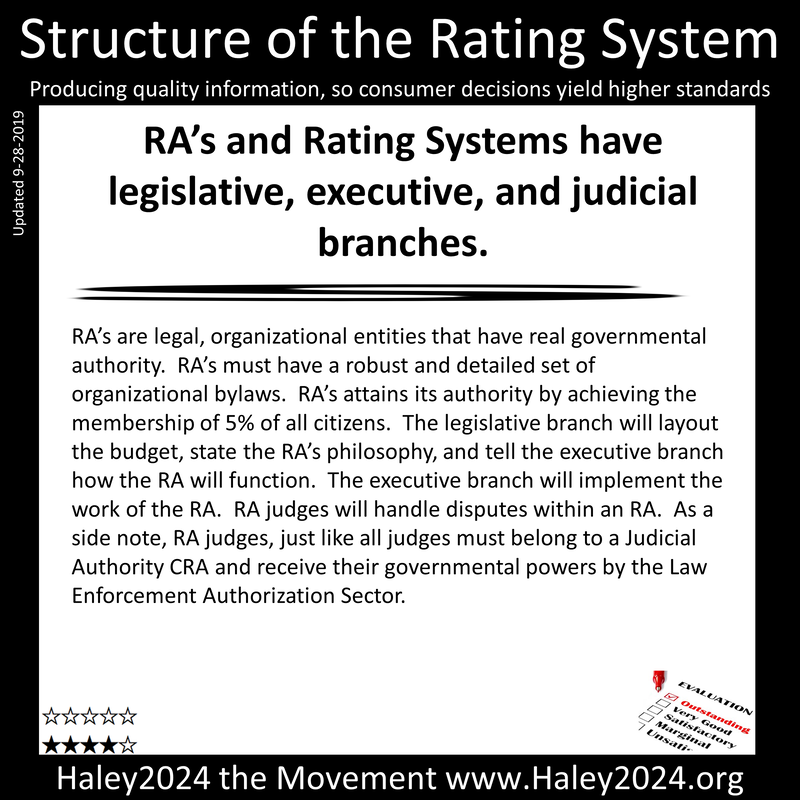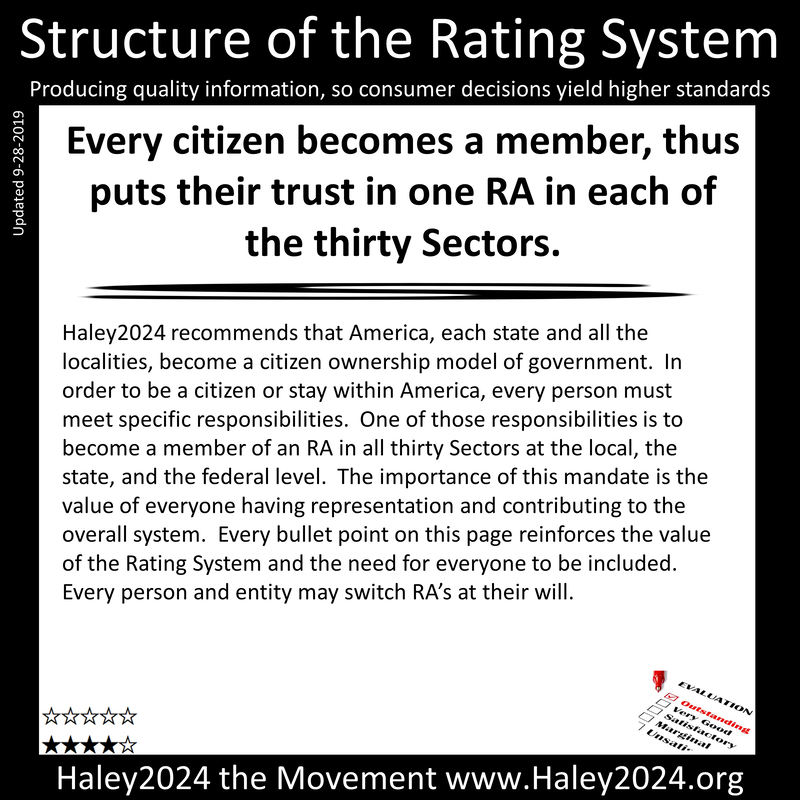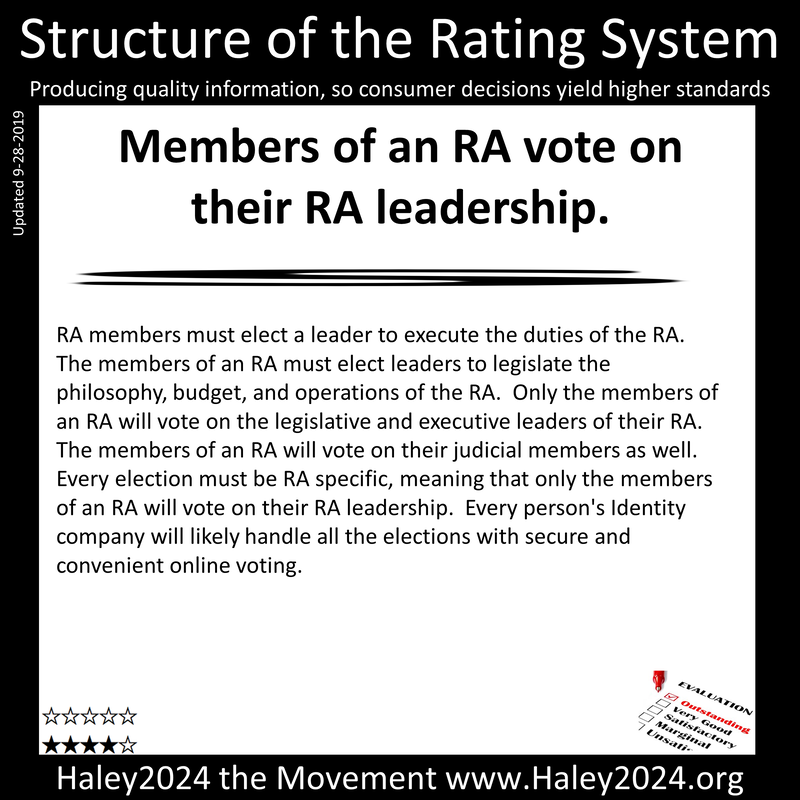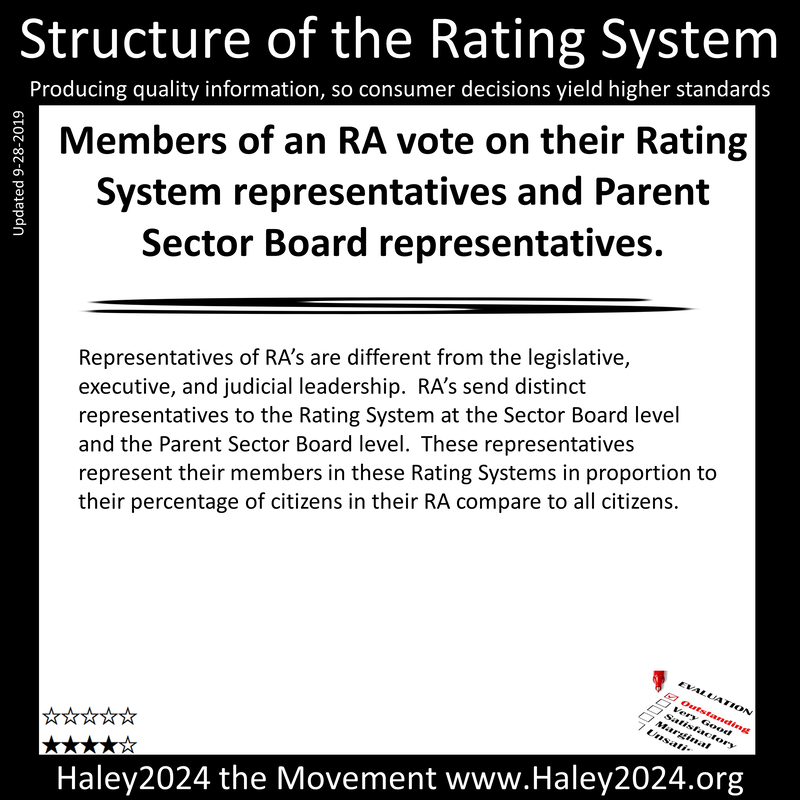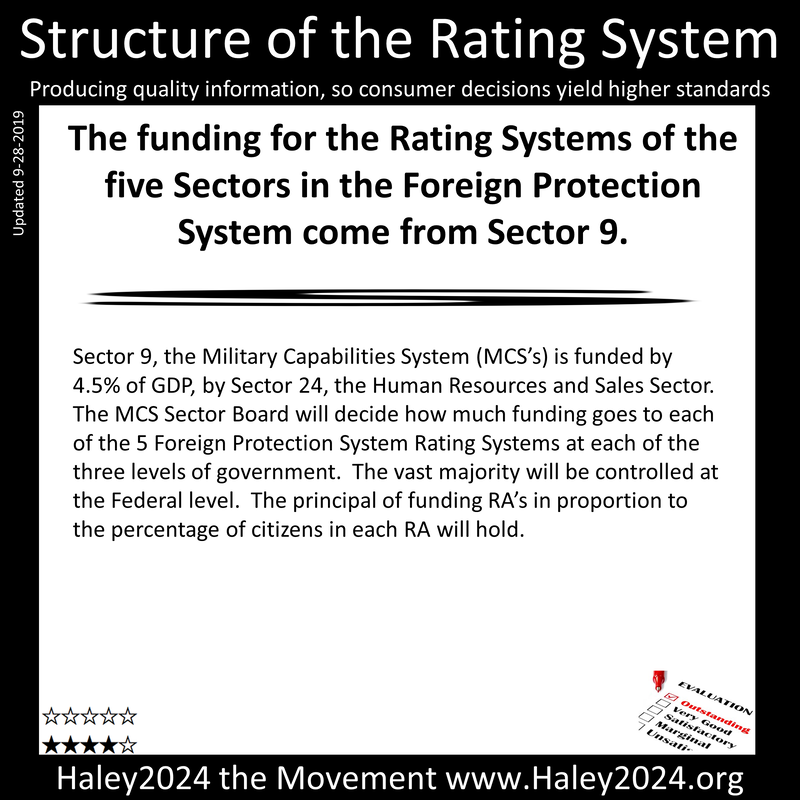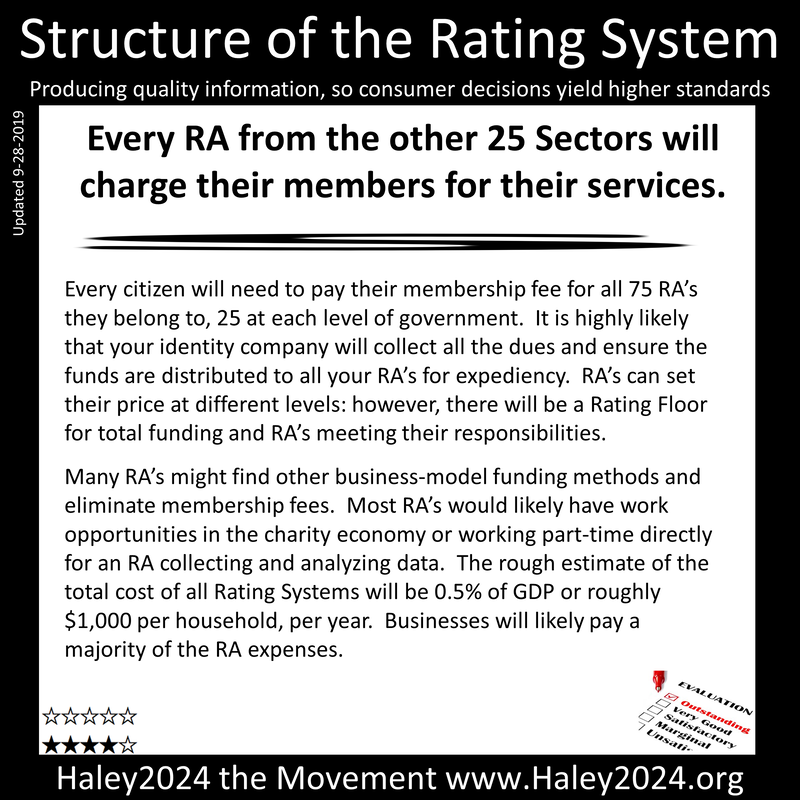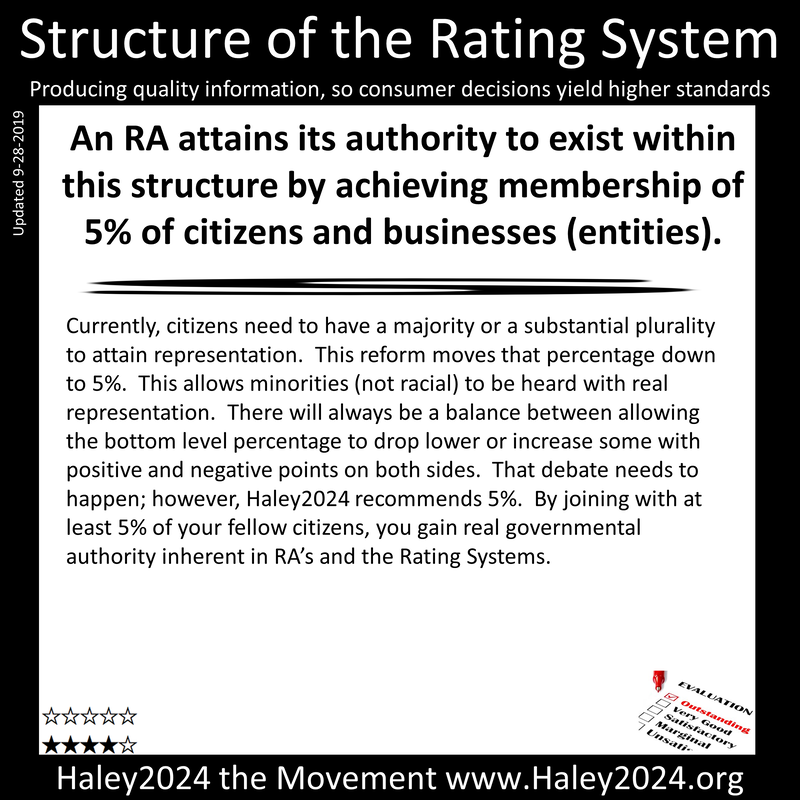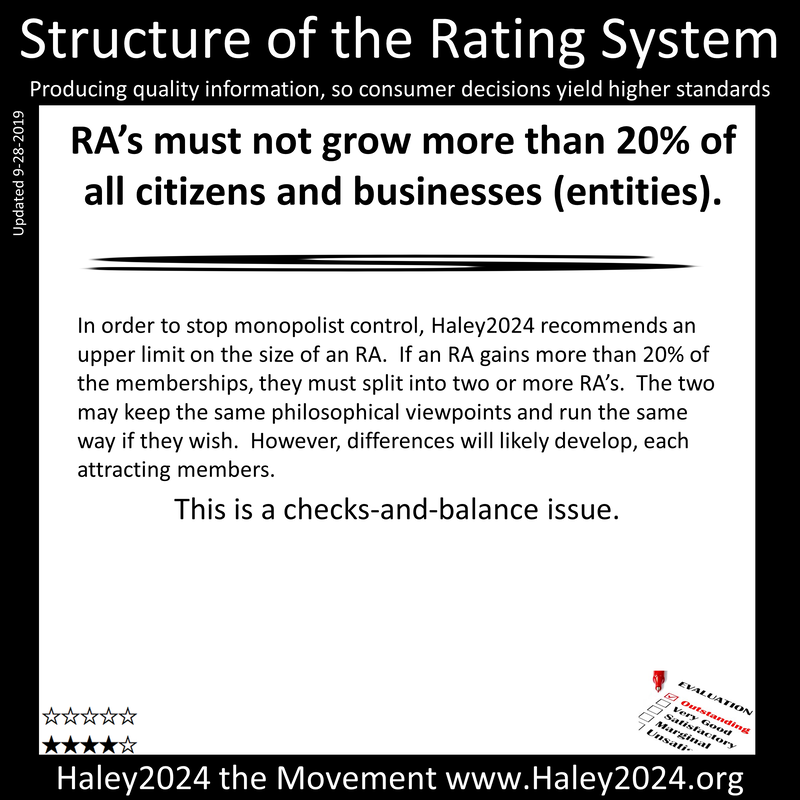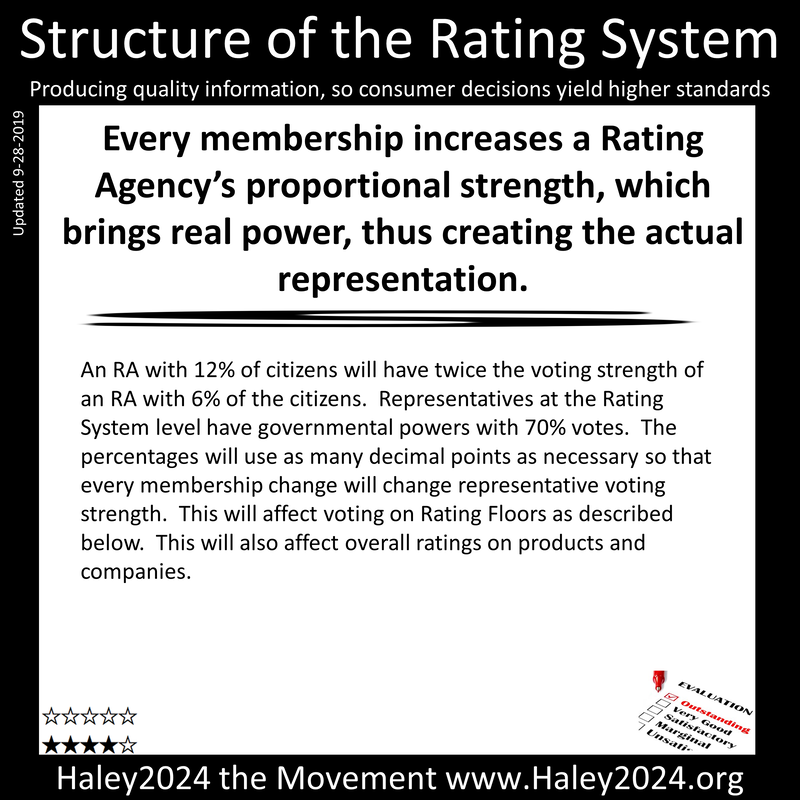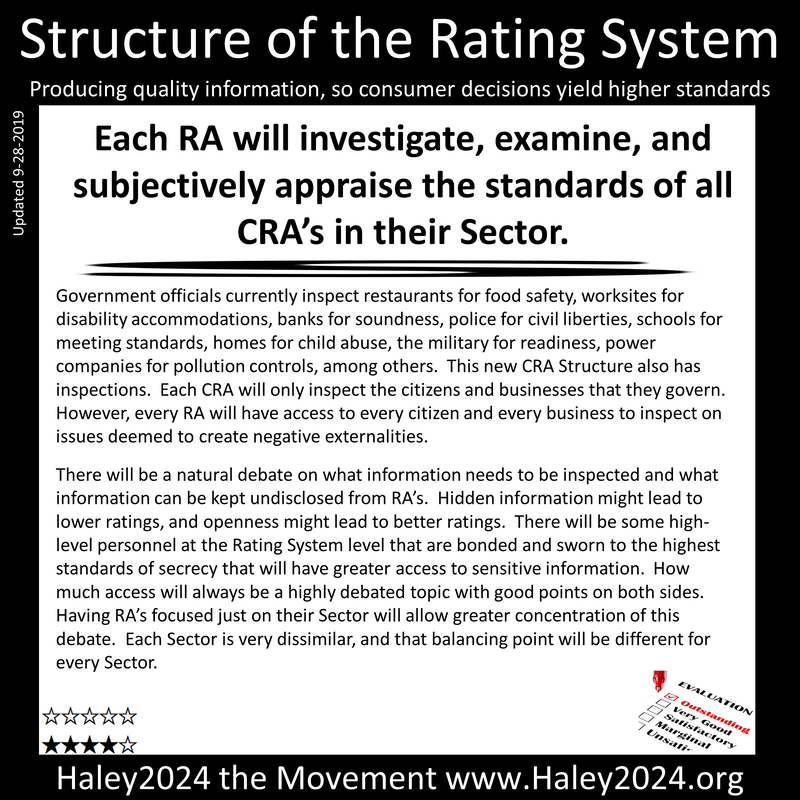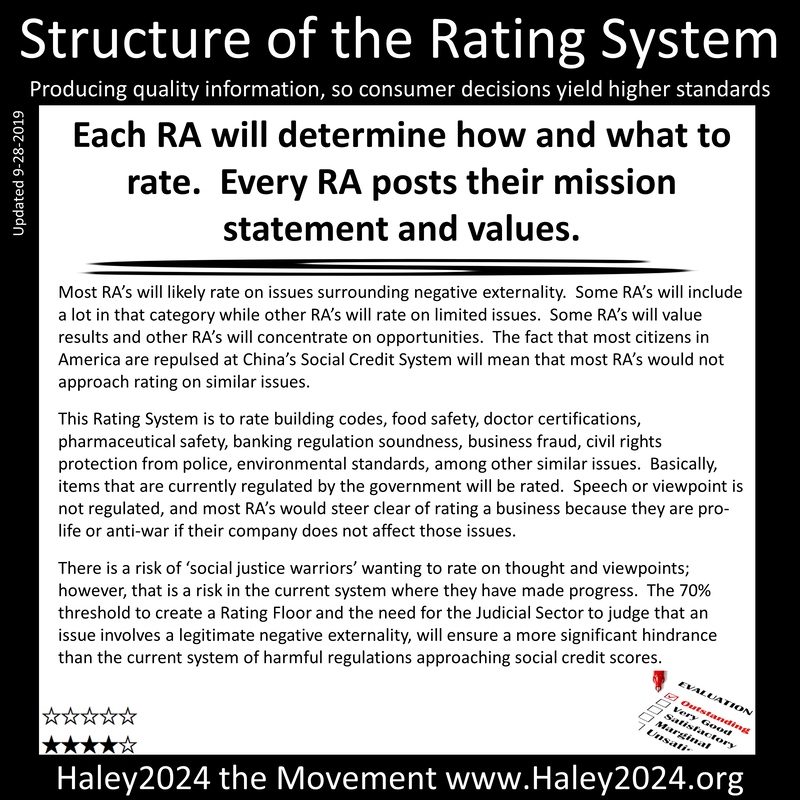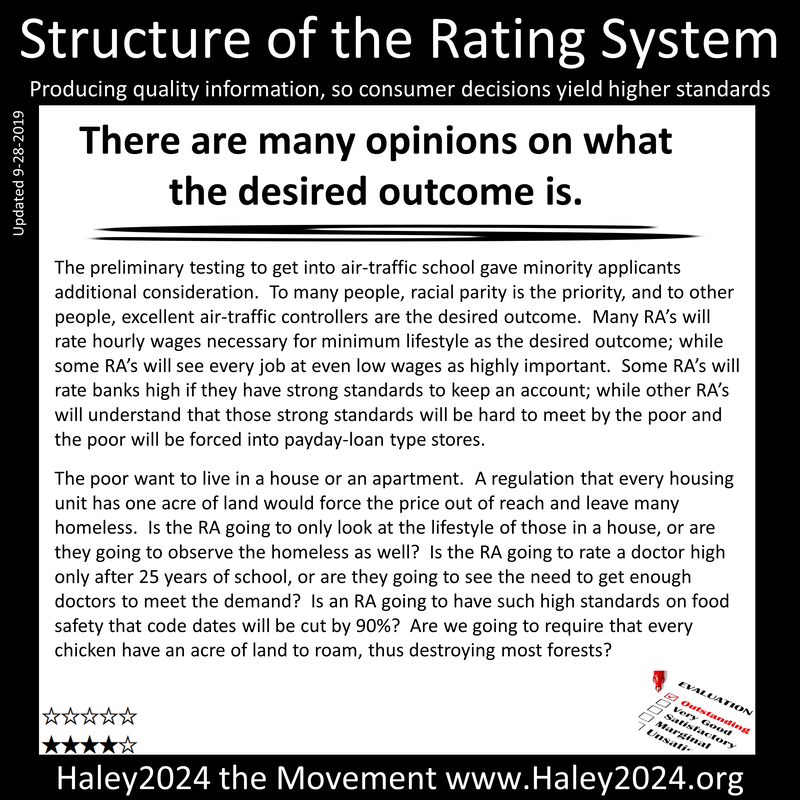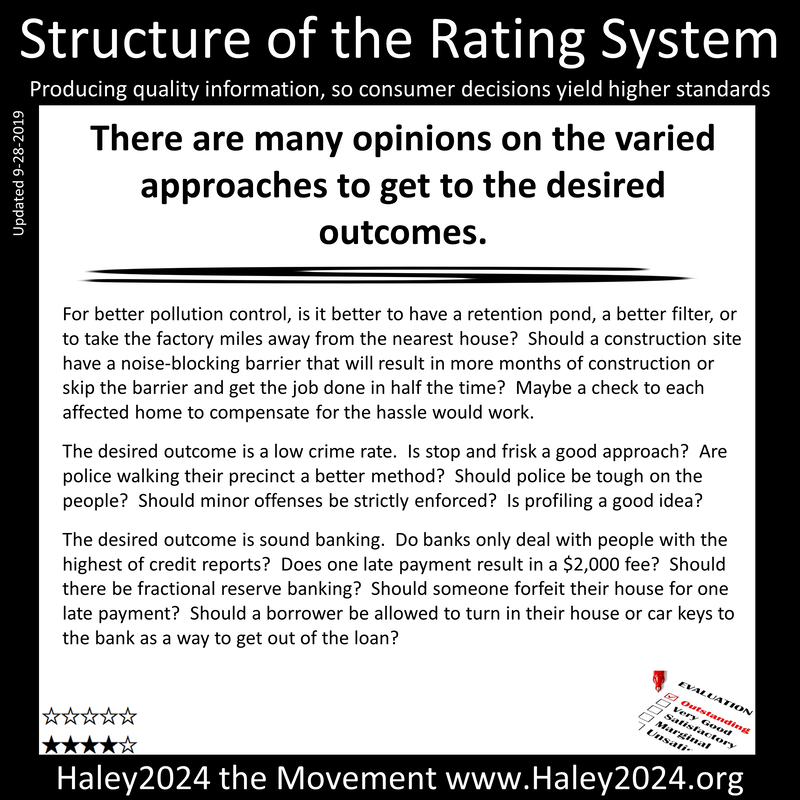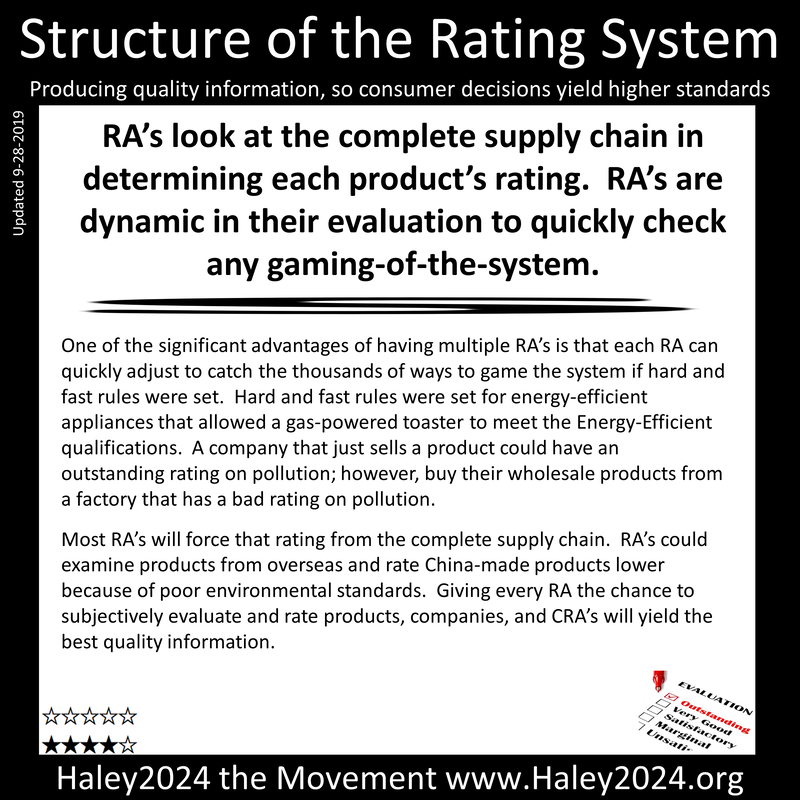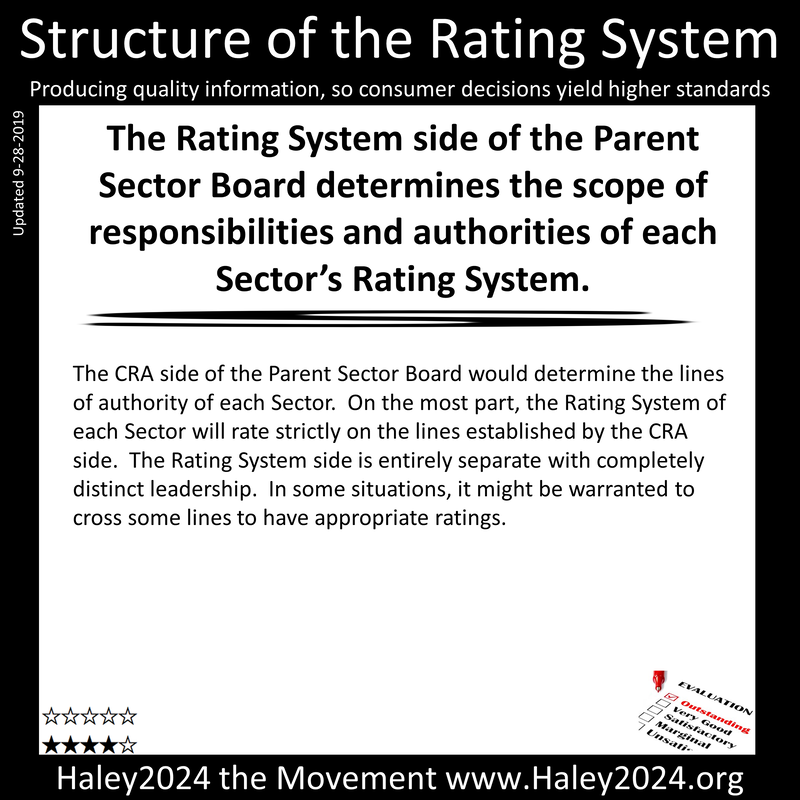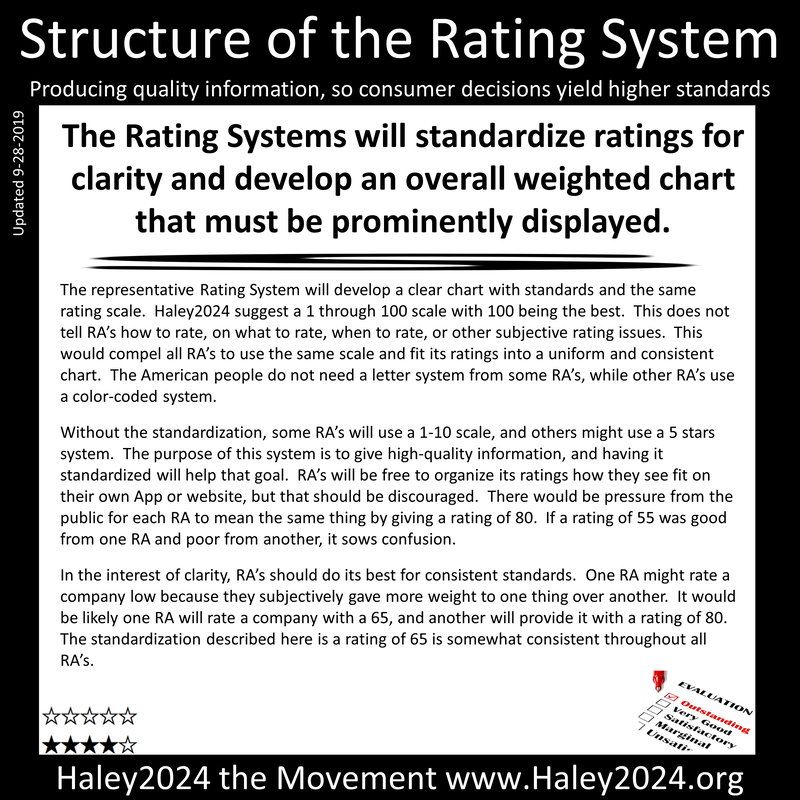Structure of the Rating System
producing quality information, so consumer decisions yield higher standards
|
On the page, The Structure of Competitive Regulatory Agencies gives much-needed information.
|
|
There are more graphics on the CRA page.
|
There will be many that will state that the Rating System is not needed as a requirement because it will develop on its own. While some Rating Systems will develop, the Haley2024’s Rating System comes with representative authority and responsibilities. The Rating System allows more government power to switch to free enterprise control. It is much more than what might develop on its own. A mandatory Rating System could encourage the political will to transition from politician control to the CRA Structure.
|
There is enormous influential power to rate and inform citizens about standards. Roughly a dozen Rating Agencies (RA’s) split this power.
It is well known that the person setting the narrative can influence the results. Ratings are going to be tremendously powerful. That power should never be in the hands of one person or a small group of people. Having roughly a dozen RA’s with different philosophies will separate that power. Every person will give their chosen RA more funding and representative authority at the Rating System level. Every citizen would have a wide variety of competing perspectives in which to examine, yielding high quality information.
|
Ratings must be prominently displayed.
The purpose of the Rating System is to provide quality information to people before they make a trade or do any economic activity. People will naturally reward better ratings and evade poor ratings. Logically, ratings will be prominently posted on doors, stores, websites, flyers, contracts, employment applications, packaging, and points of purchase. Advertising high ratings and attempts to conceal low ratings is an inevitability.
Smartphone apps are likely for all Rating Agencies. While packaging might have some key rating scores, an app can go in-depth on all the issues. The purpose of having roughly a dozen Rating Agencies competing for every citizen's trust is that everyone looks at problems differently. A dozen ways of looking at a subject provides citizens with many perspectives and quality information. A new store or product with good ratings with the RA that people trust can bring instant trust and business. |
Quality information from RA’s will result in trillions of informed decisions by billions of people leading to higher standards.
It is well known that consumers and producers will use information in which they have access to make better decisions. There is a lot of misinformation from many sources that consumers currently trust. The free enterprise system is routinely criticized because people make poor choices. Many opponents of free enterprise strawman the system as everyone having all the knowledge of job opportunities, service prospects, accurate forecasts, product availability, and prices. No economic system can even come close to any single person having over 1% of available knowledge. The Rating System’s main job is to provide quality information from many points of views and varied perspectives.
|
Ratings allow millions of people to consolidate their collective knowledge into an easy to understand rating.
Prices are a result of trillions of independent decisions by billions of people. Ratings are similar; however, based on standards. The buying public uses all the information they have when making purchasing decisions. People do not only care about money or the lowest cost. People regularly pay more when they know the increased price goes to charity, ensures more compassionate animal ranching, safeguards a better environment, or certifies that slave labor was not part of the supply chain.
|
Consumers will ensure good ratings reward positive externalities.
Often, companies do not go above and beyond if the expense is too high. If the government regulations call for filtering out 95% of pollution, it is hard to justify spending millions on getting to 96%. Sometimes the company will advertise that they achieve higher standards and that is costly in advertising funds. Experienced consumers know that advertising might be technically correct, but misleading. Often, it is challenging to distinguish the truth. The great thing about Rating Agencies is that they will specialize in in-depth investigations and knowledgeable enough to rate products, companies, CRA’s, and others.
Numerous Rating Agencies would stop favoritism, corruption, and bias. Each agency, rating on different criteria, brings different perceptions and viewpoints. Paying the extra $1 million on a better filter in a factory might increase a product’s ratings. Consumers will know at the point of purchase that the company making the product produced it more responsibly. Consumers would reward better-rated products with their purchases. |
Consumers will ensure poor ratings punish negative externalities.
There are inexpensive techniques to make a significant impact on many standards. If the government regulations did not keep up, some companies will forgo buying low-cost products that could significantly lower negative externalities. The competition will procure better products to increase standards. The Rating System will quickly rate one company better than the other and consumers would be making purchasing decisions accordingly. Consumers will quickly determine and penalize products that do not keep up with better standards.
|
There is a separate Rating System for all thirty Sectors.
Every Sector has clear lines of responsibilities. Each Sector will be a check on the other Sectors. The division of labor and responsibilities will be essential. Experts in one field will be able to concentrate on just their Sector. A Family Law RA would not need to understand product safety regulations. However, a Financial RA might have to check an Insurance RA because they are closely related. Instead of having one all-encompassing Rating System, the division allows citizens to favor a different rating philosophy for different Sectors.
|
There is a complete CRA Structure for the local level, the state level, and the Federal level.
Every Sector decides its breakdown between local, state, and federal responsibilities, which is done on the CRA side. A local RA in a particular Sector will rate on the well-defined local issues. There would likely be some crossover and RA’s at all three levels would likely have good cooperation with each other. However, it is essential for proper checks and balance purposes to officially keep three distinct levels of Rating Systems.
|
Every state has its own distinct CRA Structure. Every locality has its own distinct CRA Structure.
There is not just one state-level CRA Structure that all states must join. Every state has its own totally distinct CRA Structure. Maine has a state-level CRA Structure and Wyoming its own separate and distinct state-level CRA Structure. There are 50 distinct state CRA Structures plus a few more for US territories. It is highly likely that CRA’s will have national organizations that have distinct chapters in each state. However, it is vital that each CRA chapter is legally its own distinct legal entity.
There will be roughly 89,000 distinct local level CRA Structures. National or regional CRA organizations will assist each locality in the setup to ensure the proper legal setup. Some very small population localities might find it helpful to join together. Likewise, the ten large cities with populations over one million might find benefits in limiting its population size to roughly one million, thus separating into several at below one million. |
RA’s and Rating Systems have legislative, executive, and judicial branches.
RA’s are legal, organizational entities that have real governmental authority. RA’s must have a robust and detailed set of organizational bylaws. RA’s attains its authority by achieving the membership of 5% of all citizens. The legislative branch will layout the budget, state the RA’s philosophy, and tell the executive branch how the RA will function. The executive branch will implement the work of the RA. RA judges will handle disputes within an RA. As a side note, RA judges, just like all judges must belong to a Judicial Authority CRA and receive their governmental powers by the Law Enforcement Authorization Sector.
|
Every citizen becomes a member, thus puts their trust in one RA in each of the thirty Sectors.
Haley2024 recommends that America, each state and all the localities, become a citizen ownership model of government. In order to be a citizen or stay within America, every person must meet specific responsibilities. One of those responsibilities is to become a member of an RA in all thirty Sectors at the local, the state, and the federal level. The importance of this mandate is the value of everyone having representation and contributing to the overall system. Every bullet point on this page reinforces the value of the Rating System and the need for everyone to be included. Every person and entity may switch RA’s at their will.
|
Members of an RA vote on their RA leadership.
RA members must elect a leader to execute the duties of the RA. The members of an RA must elect leaders to legislate the philosophy, budget, and operations of the RA. Only the members of an RA will vote on the legislative and executive leaders of their RA. The members of an RA will vote on their judicial members as well. Every election must be RA specific, meaning that only the members of an RA will vote on their RA leadership. Every person's Identity company will likely handle all the elections with secure and convenient online voting.
|
Members of an RA vote on their Rating System representatives and Parent Sector Board representatives.
Representatives of RA’s are different from the legislative, executive, and judicial leadership. RA’s send distinct representatives to the Rating System at the Sector Board level and the Parent Sector Board level. These representatives represent their members in these Rating Systems in proportion to their percentage of citizens in their RA compare to all citizens.
|
The funding for the Rating Systems of the five Sectors in the Foreign Protection System come from Sector 9.
Sector 9, the Military Capabilities System (MCS’s) is funded by 4.5% of GDP, by Sector 24, the Human Resources and Sales Sector. The MCS Sector Board will decide how much funding goes to each of the 5 Foreign Protection System Rating Systems at each of the three levels of government. The vast majority will be controlled at the Federal level. The principal of funding RA’s in proportion to the percentage of citizens in each RA will hold.
|
Every RA from the other 25 Sectors will charge their members for their services.
Every citizen will need to pay their membership fee for all 75 RA’s they belong to, 25 at each level of government. It is highly likely that your identity company will collect all the dues and ensure the funds are distributed to all your RA’s for expediency. RA’s can set their price at different levels: however, there will be a Rating Floor for total funding and RA’s meeting their responsibilities. Many RA’s might find other business-model funding methods and eliminate membership fees.
Most RA’s would likely have work opportunities in the charity economy or working part-time directly for an RA collecting and analyzing data. The rough estimate of the total cost of all Rating Systems will be 0.5% of GDP or roughly $1,000 per household, per year. Businesses will likely pay a majority of the RA expenses. |
Roughly a dozen RA’s make up a Rating System.
It is vital to split the vast power of the Rating System into many Rating Agencies (RA’s). The size limitation of 5% and 20% as described below will likely result in roughly a dozen RA’s per Sector. A dozen options of RA’s will allow diverse philosophical viewpoints in which to choose. Moreover, every person can select their chosen philosophical perspective per Sector, which allows much better representation.
A person might pick a conservative Family Law RA and a liberal banking RA. If a citizen could only pick one RA that covered all 30 Sectors, a citizen might have to sacrifice their view on Labor Law in order to be represented by their viewpoint on law enforcement. Every citizen can narrowly focus on each Sector to tailor their representation. They could even switch philosophies for different levels of government. |
An RA attains its authority to exist within this structure by achieving membership of 5% of citizens and businesses (entities).
Currently, citizens need to have a majority or a substantial plurality to attain representation. This reform moves that percentage down to 5%. This allows minorities (not racial) to be heard with real representation. There will always be a balance between allowing the bottom level percentage to drop lower or increase some with positive and negative points on both sides. That debate needs to happen; however, Haley2024 recommends 5%. By joining with at least 5% of your fellow citizens, you gain real governmental authority inherent in RA’s and the Rating Systems.
|
RA’s must not grow more than 20% of all citizens and businesses (entities).
In order to stop monopolist control, Haley2024 recommends an upper limit on the size of an RA. If an RA gains more than 20% of the memberships, they must split into two or more RA’s. The two may keep the same philosophical viewpoints and run the same way if they wish. However, differences will likely develop, each attracting members.
This is a checks-and-balance issue. |
Every membership increases a Rating Agency’s proportional strength, which brings real power, thus creating the actual representation.
An RA with 12% of citizens will have twice the voting strength of an RA with 6% of the citizens. Representatives at the Rating System level have governmental powers with 70% votes. The percentages will use as many decimal points as necessary so that every membership change will change representative voting strength. This will affect voting on Rating Floors as described below. This will also affect overall ratings on products and companies.
|
Each RA will investigate, examine, and subjectively appraise the standards of all CRA’s in their Sector.Government officials currently inspect restaurants for food safety, worksites for disability accommodations, banks for soundness, police for civil liberties, schools for meeting standards, homes for child abuse, the military for readiness, power companies for pollution controls, among others. This new CRA Structure also has inspections. Each CRA will only inspect the citizens and businesses that they govern. However, every RA will have access to every citizen and every business to inspect on issues deemed to create negative externalities.
There will be a natural debate on what information needs to be inspected and what information can be kept undisclosed from RA’s. Hidden information might lead to lower ratings, and openness might lead to better ratings. There will be some high-level personnel at the Rating System level that are bonded and sworn to the highest standards of secrecy that will have greater access to sensitive information. How much access will always be a highly debated topic with good points on both sides. Having RA’s focused just on their Sector will allow greater concentration of this debate. Each Sector is very dissimilar, and that balancing point will be different for every Sector. |
Each RA will determine how and what to rate. Every RA posts their mission statement and values.
Most RA’s will likely rate on issues surrounding negative externality. Some RA’s will include a lot in that category while other RA’s will rate on limited issues. Some RA’s will value results and other RA’s will concentrate on opportunities. The fact that most citizens in America are repulsed at China’s Social Credit System will mean that most RA’s would not approach rating on similar issues.
This Rating System is to rate building codes, food safety, doctor certifications, pharmaceutical safety, banking regulation soundness, business fraud, civil rights protection from police, environmental standards, among other similar issues. Basically, items that are currently regulated by the government will be rated. Speech or viewpoint is not regulated, and most RA’s would steer clear of rating a business because they are pro-life or anti-war if their company does not affect those issues. There is a risk of ‘social justice warriors’ wanting to rate on thought and viewpoints; however, that is a risk in the current system where they have made progress. The 70% threshold to create a Rating Floor and the need for the Judicial Sector to judge that an issue involves a legitimate negative externality, will ensure a more significant hindrance than the current system of harmful regulations approaching social credit scores. |
Some RA’s will look at second and third-order effects.
Some RA’s will look narrowly at the pollution from a factory and not reason some relevant indirect effects. A heavier car might pollute more; however, result in less harm in crashes. An expensive filter to remove 98.5% compared to the previous 98% of pollutants might exhaust the budget, not leaving the funds for a retention pond. The increased cost to decrease negative externalities might put the service out of financial reach for many people, causing a greater risk. If a new car needed every safety bell and whistle, would people drive older and less safe vehicles?
How many people represent themselves in court because the cost of a lawyer is too high? Should people have the option of hiring a less skilled than a fully accredited lawyer at half the price? Drinking too much water has killed people in the past, should RA’s rate selling water low or realize the dose makes the poison? Some people get too frustrated with some safety features and remove the entire device creating higher risk compared to an easy to use device with moderate safety features. A pill bottle that takes ten minutes and a YouTube video to open will likely be left open to avoid the hassle. Having super safe loan requirements will result in only the people with the highest credit scores attaining the loans. Trying to achieve race proportional equity in mortgages have resulted in lower underwriting standards for some races that cause harm to people in that race. The list is endless, the current government regulations meant to help and protect people have had a host of unintentional adverse outcomes. |
There are many opinions on what the desired outcome is.
The preliminary testing to get into air-traffic school gave minority applicants additional consideration. To many people, racial parity is the priority, and to other people, excellent air-traffic controllers are the desired outcome. Many RA’s will rate hourly wages necessary for minimum lifestyle as the desired outcome; while some RA’s will see every job at even low wages as highly important. Some RA’s will rate banks high if they have strong standards to keep an account; while other RA’s will understand that those strong standards will be hard to meet by the poor and the poor will be forced into payday-loan type stores.
The poor want to live in a house or an apartment. A regulation that every housing unit has one acre of land would force the price out of reach and leave many homeless. Is the RA going to only look at the lifestyle of those in a house, or are they going to observe the homeless as well? Is the RA going to rate a doctor high only after 25 years of school, or are they going to see the need to get enough doctors to meet the demand? Is an RA going to have such high standards on food safety that code dates will be cut by 90%? Are we going to require that every chicken have an acre of land to roam, thus destroying most forests? |
There are many opinions on the varied approaches to get to the desired outcomes.
For better pollution control, is it better to have a retention pond, a better filter, or to take the factory miles away from the nearest house? Should a construction site have a noise-blocking barrier that will result in more months of construction or skip the barrier and get the job done in half the time? Maybe a check to each affected home to compensate for the hassle would work.
The desired outcome is a low crime rate. Is stop and frisk a good approach? Are police walking their precinct a better method? Should police be tough on the people? Should minor offenses be strictly enforced? Is profiling a good idea? The desired outcome is sound banking. Do banks only deal with people with the highest of credit reports? Does one late payment result in a $2,000 fee? Should there be fractional reserve banking? Should someone forfeit their house for one late payment? Should a borrower be allowed to turn in their house or car keys to the bank as a way to get out of the loan? |
RA’s look at the complete supply chain in determining each product’s rating. RA’s are dynamic in their evaluation to quickly check any gaming-of-the-system.
One of the significant advantages of having multiple RA’s is that each RA can quickly adjust to catch the thousands of ways to game the system if hard and fast rules were set. Hard and fast rules were set for energy-efficient appliances that allowed a gas-powered toaster to meet the Energy-Efficient qualifications. A company that just sells a product could have an outstanding rating on pollution; however, buy their wholesale products from a factory that has a bad rating on pollution.
Most RA’s will force that rating from the complete supply chain. RA’s could examine products from overseas and rate China-made products lower because of poor environmental standards. Giving every RA the chance to subjectively evaluate and rate products, companies, and CRA’s will yield the best quality information. |
The Rating System side of the Parent Sector Board determines the scope of responsibilities and authorities of each Sector’s Rating System.
The CRA side of the Parent Sector Board would determine the lines of authority of each Sector. On the most part, the Rating System of each Sector will rate strictly on the lines established by the CRA side. The Rating System side is entirely separate with completely distinct leadership. In some situations, it might be warranted to cross some lines to have appropriate ratings.
|
When a regulation concerns activity that harms people outside of the transaction or contract, the Rating System in that Sector may put a Rating Floor of that set of regulations with a vote of 70% of RA representatives in the Rating System.
Most regulations will only affect the parties doing a transaction. The transition to private waterways, private parks, and private roads will result in almost all land and water being in the hands of private parties. Therefore, pollution and other effects will affect only the parties involved in a set of regulations. There will still be some activity that creates a lot of noise such as an airport, a lot of odors such as a pig farm, a lot of danger such as a building open to the public, among others that cause the greater community negative externalities.
Most companies will seek high ratings because they know the buying public will penalize companies and products with lower ratings, however, as a safety measure in the rare instances where someone does not care, the Rating Floors will not allow standards below a specific level. |
The Rating Systems will standardize ratings for clarity and develop an overall weighted chart that must be prominently displayed.
The representative Rating System will develop a clear chart with standards and the same rating scale. Haley2024 suggest a 1 through 100 scale with 100 being the best. This does not tell RA’s how to rate, on what to rate, when to rate, or other subjective rating issues. This would compel all RA’s to use the same scale and fit its ratings into a uniform and consistent chart. The American people do not need a letter system from some RA’s, while other RA’s use a color-coded system.
Without the standardization, some RA’s will use a 1-10 scale, and others might use a 5 stars system. The purpose of this system is to give high-quality information, and having it standardized will help that goal. RA’s will be free to organize its ratings how they see fit on their own App or website, but that should be discouraged. There would be pressure from the public for each RA to mean the same thing by giving a rating of 80. If a rating of 55 was good from one RA and poor from another, it sows confusion. In the interest of clarity, RA’s should do its best for consistent standards. One RA might rate a company low because they subjectively gave more weight to one thing over another. It would be likely one RA will rate a company with a 65, and another will provide it with a rating of 80. The standardization described here is a rating of 65 is somewhat consistent throughout all RA’s. |
RA’s will have oversight power to protect civil rights in CRAs’ judicial authorities.
One large concerning issue of going to the CRA Structure is that of proper civil rights protection. The Rating System will have original authority to set a high Rating Floor on civil liberty protections within all court systems. The first appellate court at the CRA Sector Board level will be able to correct lower CRA courts that failed to respect civil liberties.
These private courts have the judicial authority that must be authorized by the Law Enforcement Authorization (LEA) Sector. The representatives of the LEA must vote at a 70% margin to authorize prosecutors, judges and others with judicial governmental powers. While the current system has politicians overseeing the process, the CRA structure will have six distinct representative bodies that have many people concentrating strictly on these judicial issues. |
Properly informing consumers of negative or positive environmental externalities allow patrons to punish or reward producers regarding pollution controls, thus putting a price on externalities and yielding a cleaner environment.If every store, company, and product had an environmental rating that people trusted, consumers would naturally choose the better-rated products. Consumers might not pay double if the environmental ratings are only 1% higher, but a significant difference in ratings would cause consumers to pay a reasonable surcharge for better ratings. The complete supply chain would likely be involved in the ratings. A company would always see competitive advantages to making inexpensive but meaningful improvements.
|

